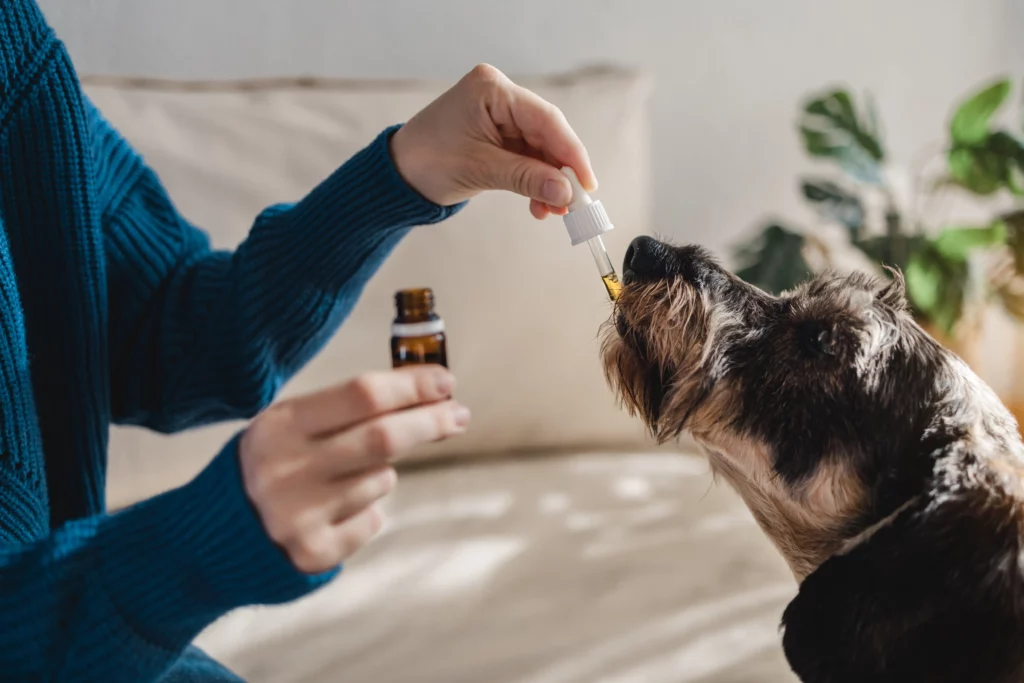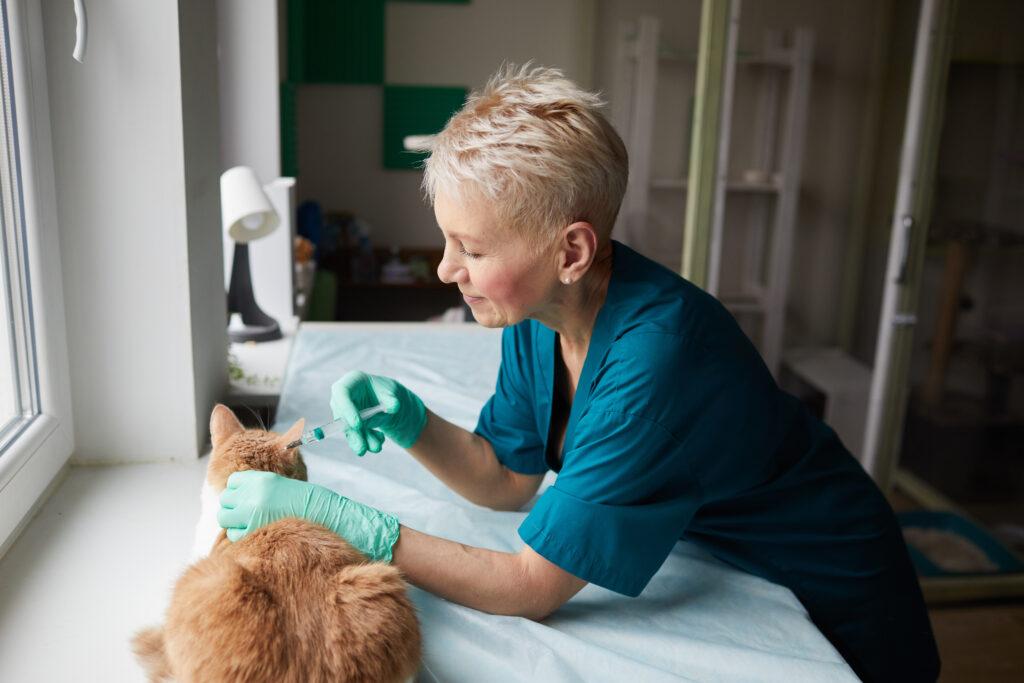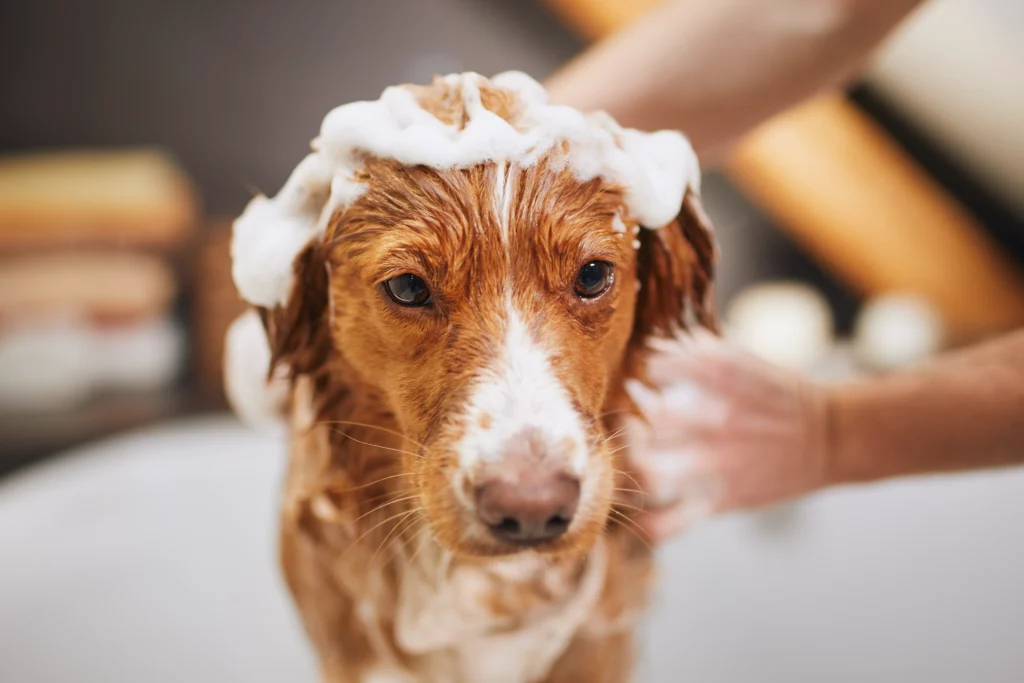
Skin rash on dogs is a common issue that dog owners face routinely. Estimates suggest that nearly one in five dogs will experience some form of skin allergies or rash in their lifetime.
These skin issues are not just uncomfortable for your canine companions, but they can also be indicative of more severe health problems if left untreated.
In this article, we will run you through three essential steps to help you tackle skin rash on dogs: recognizing the signs, seeking professional advice, and adhering to ongoing preventative measures.
Let's dive into these steps to ensure your furry friend stays happy and healthy!
First, it's crucial to identify the root cause of your dog's skin rash to tackle the problem.
For instance, treating a skin rash caused by an allergy with anti-parasite medication won't work. Once the root cause is known, proper treatment can alleviate symptoms and address the underlying problem.
Let's look at some of the most common triggers:
Learn: 6 Alarming Symptoms of itchy skin in dogs

A veterinarian can detect early signs of skin issues, identify potential allergens or parasitic infestations, and provide necessary vaccinations to prevent bacterial or fungal infections.
Regular check-ups also present an opportunity to discuss your dog's diet and environmental factors that could cause skin problems.
Hypoallergenic shampoos are a good choice for dogs with sensitive skin or allergies. If your dog has dry skin, consider a moisturizing shampoo.
Bathing your dog with a dog-friendly shampoo will keep your pet tidy and smelling pleasant and help manage skin conditions and relieve irritations.
Always avoid human shampoos, as they can disrupt the natural pH balance of your dog's skin and cause irritation.
Related: 6 Environmental Allergies in Dogs
The number of baths will depend on your dog's breed, lifestyle, and skin condition.
Generally, a monthly bath is sufficient for most dogs, but dogs with skin conditions or who spend much time outdoors might need more frequent baths.
Always consult your vet to determine the best bathing routine for your dog.
Discover The Best Skin and Coat Conditioner for Dogs
Regular brushing helps distribute natural oils, removes loose fur, and prevents matting. Brushing also allows you to check your pet's skin for signs of rashes, parasites, or infections.
Read: 6 Easy Steps For Dog Grooming at Home

A clean living environment contributes to overall skin health and can help prevent skin rash on dogs.
Washing Bedding and Toys: Regular washing of your dog's bedding and toys can remove allergens and parasites that may cause skin irritation. Use a pet-friendly detergent and make sure everything is thoroughly dried to prevent mildew.
Vacuuming and Cleaning Common Areas: Keeping the areas where your dog frequently spends time clean is also important. Regular vacuuming can reduce the presence of allergens and parasites in your home. Use pet-friendly cleaning products to avoid causing skin rashes and irritation.
An adequate, balanced diet can help nourish your dog's skin from the inside out, fortifying it against environmental aggressors and internal imbalances that can lead to skin rashes and other issues. Conversely, a poor diet lacking essential nutrients can lead to a dull coat, dry skin, and various dermatological problems.
Omega-3 fatty acids, commonly found in fish and flaxseeds, offer significant skin benefits for dogs. They have anti-inflammatory properties, which can help alleviate skin redness, itchiness, and swelling associated with rashes. Incorporating this essential fatty acid in your dog's diet can promote a glossy coat and healthy skin.
Protein aids tissue repair and maintenance, crucial for dogs suffering from rashes or other skin conditions. High-quality protein sources such as chicken, beef, fish, and eggs can provide this essential nutrient.
Hydration maintains skin elasticity and prevents dryness, which can lead to itching and skin rash on dogs. Ensuring your pet friend has constant access to fresh, clean water is a simple yet effective way to support their skin health.
While these general guidelines can be beneficial, it's crucial to remember that each dog has unique nutritional needs. That's why consulting with a veterinarian is invaluable for getting personalized dietary advice.
A vet can make specific diet recommendations based on your dog's breed, age, size, and overall health, helping you choose the best food and supplements to maintain healthy skin and coat.

Once veterinarians identify the cause of your dog's skin rash, they can initiate targeted treatment, which may involve over-the-counter treatments, prescription medications, home remedies, or a combination of these approaches.
Antihistamines and topical creams, available over-the-counter (OTC), can relieve common skin rashes by treating symptoms such as itching, redness, and swelling.
Remember, seeking veterinary advice before applying any OTC product is essential to ensure it's safe and suitable for your pet's condition.
In milder cases or as an adjunctive treatment, specific home remedies can be beneficial.
Aloe Vera and Oatmeal Baths
A bath with a shampoo containing aloe vera and oatmeal can help alleviate your dog's discomfort due to these’s natural soothing and healing properties.
Coconut Oil for Moisturizing
Applying coconut oil to your dog's skin can help alleviate dryness and flaking associated with skin rash on dogs.
Herbal Remedies like Chamomile for Soothing Effects
Chamomile can have calming effects on irritated skin. A chamomile tea rinse or a poultice can be a soothing treatment option for your dog's skin rash.
Your vet may prescribe medication to treat your dog's skin rash in more severe cases. It could include antibiotics for bacterial infections, antifungal medications for fungal rashes, or steroids for painful inflammatory conditions.
Always follow your vet's instructions for dosage and duration of treatment to ensure the effectiveness of the medicine and prevent potential side effects.
AniViva® Animal Health Serum is a specially formulated cosmetic skin conditioner and moisturizer designed to promote your pet's health. Enriched with a concentrated blend of Zinc, Copper, and Magnesium, this unique serum comes in a convenient spray pump bottle.
Suitable for a range of pets, including cats, dogs, horses, and other animals, AniViva® Animal Health Serum is a topical nutritional aid that can significantly enhance your pet's overall health. It mainly benefits their coat health and can efficiently address skin rash issues.
What sets AniViva® Animal Health Serum apart is its environmentally friendly formula. Free of oil and alcohol, minimizing the chance of skin irritation.
Regardless of the treatment method chosen, it's crucial to follow dosage instructions and consult a vet regularly. Overdosing or underdosing can lead to ineffective treatment or unwanted side effects.
Consulting your vet ensures that they safely, appropriately, and effectively monitor the treatment for your dog's skin rash.

Investing in prevention strategies is crucial for maintaining your dog's long-term skin health and preventing recurring skin rashes. Here are some key strategies to consider:
Regular veterinary check-ups can help detect early signs of skin issues before they escalate into more severe conditions. Preventive care, including vaccinations and routine skin examinations, can help keep your dog's skin healthy and rash-free.
Parasites are a common cause of skin rashes in dogs. Implementing a year-round parasite control plan, including regular flea and tick treatments, can help prevent infestations that lead to skin irritation and rashes.
Pay close attention to changes in your dog's behavior or skin condition, as these may be early signs of a developing skin issue. Frequent scratching, excessive licking, or the appearance of red patches could indicate a skin rash on dogs. Early detection and treatment can help prevent further discomfort and potential complications.
Managing and resolving skin rashes on dogs involves three pivotal steps.
Consistent care and attention are crucial in maintaining your dog's skin health, preventing future issues, and ensuring their overall well-being.
It involves regular vet check-ups, a year-round parasite control plan, and keen observation of your dog's behavior and skin condition for any signs of discomfort or rash development.
To all dog owners, we encourage you to stay proactive in maintaining and improving your pet's skin health. You can help your furry friend lead a happy, healthy, and rash-free life with patience, understanding, and a committed approach.
Remember, the best care is preventative care. Your dog's skin health, comfort, and happiness depend on it. Experience our AniViva® pet series here.

Did you know that cats can get dandruff too? Just like humans, their skin can become dry and flake when petted. While it's usually not a symptom, figure out the root cause to provide the best treatment. In most cases, helping your cat skin dryness takes a few easy steps.
Cats' dry skin can be a sign of dietary deficiencies. Omega-3 fatty acids and zinc are necessary for a balanced diet that will help maintain healthy skin and coat.
Dry skin may factor in due to an overweight cat or mobility problems that prevent adequate grooming. It can lead to hair matting, inflammation, and flaking. Regular exercise and nutritionally balanced meals can help prevent this.

Is your cat's fur lackluster? Are you seeing white flakes in their coat? These could be signs of dry skin. Other symptoms include excessive scratching and a lack of shine to the fur.
Does your cat have an itch it can't seem to scratch? Dry skin could be the culprit! Itchy, inflamed skin is a common symptom and can often link to dermatitis.
On top of this, cats suffer from dry skin and often show signs of dandruff - small white flakes in their fur. While usually not serious, if you see this in combination with other symptoms, a bigger underlying problem might be at hand.
If you observe your pet scratching itself frequently, it may be experiencing some irritation from its skin. It can manifest as a patchy coat or baldness, so keep an eye out for any significant changes to the texture and appearance of your pet's fur.
It is important to note that if your cat is continuously licking at its skin, the problem might be more severe than dryness - ask your vet if you notice particularly concerning behavior.
Cat skin dryness can indicate something else - allergies, infections, and parasites can all contribute to flakiness, itching, and unkempt fur. You may also notice your cat self-grooming more often than usual. The key to helping your pet is to identify the underlying cause of the dry skin and provide appropriate treatment.
In colder months, the dry air of a heated environment can lead to dehydration. During the summer, sensitive skin may become dried out when exposed to air conditioning machines. Furthermore, cigarette smoke, fragrances, and household chemicals may influence your cat's uncomfortable skin condition.
Use humidifiers throughout the house to increase the overall humidity levels. Keeping your cat well hydrated is also essential for internal hydration and will support a healthy coat.
When bath time rolls around, choose shampoos and conditioners that are specially formulated for cats and designed to be moisturizing. It can aid in combating dry, itchy skin.
Excessive skin and hair buildup on the coat can cause dry, unhealthy skin. Cats with limited mobility, such as arthritis or obesity, can’t groom themselves properly.
Regular brushing may prevent excess fur from accumulating and trapping moisture close to the cat's skin.
If your cat's inability to groom is related to obesity, consult your veterinarian about crafting a plan that helps them lose excess weight. Taking this step not only allows them to groom themselves better but will overall benefit their health.
When the problem is due to arthritis or any other medical condition, your vet will devise a treatment plan tailored to that specific case and may also provide medication for pain management.
Excessive grooming can also lead to dry skin and hair loss. Cats generally itch or feel uncomfortable when over-grooming to reduce the sensation.
Cats don't need regular baths - unless they are dirty or have a skin issue. While occasional bathing with a cat-safe shampoo may be alright, frequent baths can lead their skin to become dry.
Treatment
The ideal way to treat dry skin caused by frequent bathing is to reduce the frequency of baths. If your cat has a medical condition that hinders their grooming process, speak to your veterinarian about what bathing routine will suit them without making their skin and coat oil-deficient.
Home-prepared diets may be well-intentioned but don’t provide balanced and complete nutrition. Even commercial food products could prove ill-suited for some cats. Generally, cats do best on moist foods high in protein and low in carbohydrates.
Introduce a high-quality, well-balanced diet. Consult with your veterinarian concerning the best quality commercial foods for your cat. If they lack nutrients, it's advisable to have them assessed and get your vet's advice on the correct meals.
Parasites:
External parasites like fleas or mites on the skin may cause the skin to develop a dry, flaky appearance. In some cases, fleas and flea dirt are visible to the naked eye, but fastidious cats may remove evidence of fleas while grooming. Most mites aren’t evident. Cheyletiella mites are an exception and are often called "walking dandruff."
Allergen exposure can prompt a cat's immune system to respond in the form of itchy, inflamed, and dry skin. Possible allergens include pollen, dust mites, food, chemicals, and fragrances.
Bacterial and fungal infections are common contributors to this issue, and if left untreated, the condition may worsen over time.
Treatment for a cat's skin disease will depend on whether it is bacterial or fungal. Antibiotics are prescribed for bacterial infections, while the antifungal medication is the go-to for fungal ones. These medications can be taken orally or applied topically.
Systemic diseases, hyperthyroidism, diabetes, kidney disease, or heart disease can cause skin issues. For some, it may directly affect the skin's appearance. Even when this is not the case, cats that suffer from these conditions might not be able to groom themselves properly, leading to a dry, flaky complexion.
A veterinarian must diagnose and evaluate before determining the most suitable treatment option for hyperthyroidism in an individual cat. Various treatments are available, including medications, radioactive iodine therapy, surgical procedures, and dietary adjustments.
Seeking help leads to a good prognosis. Otherwise, health complications may arise.
Stress also affects the skin and coat of cats, just as it does on humans. Various situations can be distressing, such as moving to a new home, welcoming a new family member or pet into their environment, noise from outside the house or other events, and sickness.

After reading through the causes of cat skin dryness, it’s your turn to attend to your cat. Casual grooming sessions to examine their fur are encouraged, but remember that overdoing it can lead to much more discomfort and dryness.
As a pet parent, learn the health hazards your feline friend could experience. Doing so will help prevent or prepare you for addressing the underlying issue.
Do Cats Need Baths? Read here.
Our cosmetic skin conditioner and moisturizer promote animal health through its Zinc-Copper-Magnesium concentrated formula. Your pets will look and feel their best with AniViva! View our products here.

Taking your dog to the beach sounds like a dream come true; it’s fun to watch their happy face at the scenery of the ocean. But not all breeds look forward to a sandy day.
Before hitting the spot with your best pal, ensure they can swim - e.i. Basset hounds can’t swim.
If they pass the swimming test, your pet will be in for a treat; the beach may provide a new experience, sounds, and smells, along with some fun games!
Maximize the outing with this insight into activities, training behavior, and preventions.
Before jumping on your beach adventure with your four-legged friend, there are a few things you need to do to prepare.
Follow these recommendations to enjoy the beach without any unexpected hiccups.
Pack the Essentials
Gather a bowl for water, food, treats, toys, towels, and poop bags. Check the weather and consider bringing a cooling mat or vest to keep your pup comfortable.
Check Leash Laws
Different beaches have different rules when it comes to dog to the beach. Some may require keeping your dog on a leach - yikes! While others may allow off-leash play in designated areas. Research the rules of the specific beach before visiting.
Prep Your Dog
Is it their first time, or are they a little rusty since the last time? It's a good idea to prepare them ahead of time. Practice basic obedience commands like "come" and "stay," getting them used to walking on sand and encountering new smells and sounds.
Consider Sun Protection
Just like humans can get sunburned, dogs can too! If your pup has short hair or light-colored fur, consider applying pet-safe sunscreen before heading out. Find a shaded spot or bring your artifact to have shade, improving the adventure without getting sunburned!

Do fun activities with your best friend to make the most of them at the beach!
Keep an Eye on Your Dog
While it can be tempting to let your dog off-leash and run free on the beach, monitoring their being will help them not to get into dangerous situations or bother other people or dogs nearby.
Provide Plenty of Water
Dogs can get dehydrated quickly, especially in hot weather. Bring enough water for both you and your pup and offer it frequently throughout the day.
Playtime!
The beach is a great place to play games with your dog! Bring toys like frisbees or balls and play fetch in the water or sand. Remember to stay close to the shore if playing in the water.
Go for a walk
Adventure on shore, let your best pal feel the sand, and waves, take in the scents and watch crabs.
Build sand castles
Then record how your dog destroys it with a smile on its face.
Get on a boat!
Witness the immensity of the ocean riding a boat and take your canine friend to enjoy the view as well.
Take Breaks
Even if your dog seems restless, take plenty of breaks throughout the day to not get overtired or overheat. Find a shady spot to rest and relax together.
Be Mindful of Others
Remember that not everyone loves dogs as much as you do! Be respectful of other beachgoers by keeping your dog under control and cleaning up after them if they go potty on the sand.
To ensure your visit to the beach goes great, prepare your dog with basic obedience training, either verbal or hand signals.
If your dog isn’t ready for that type of freedom, stick to keeping them on a leash and enjoy a walk on the beach.
A top command would be, “leave it” since your dog might be interested in eating things it finds on the beach, trash, dead fish, or somebody else’s food, “leave it” helps to communicate they can’t proceed.
What’s your dog’s personality? Are they social butterflies or shy and aggressive with others? Pick a day, time, and spot that suits the attitude since beaches can get busy, and it’s about having a good time and not spending too much time monitoring them.

After a fun day at the beach, do your part in keeping the beach clean and safe for everyone.
Remember some tips for cleaning up after your dog:
Bring Plenty of Poop Bags
Make sure you bring plenty of poop bags to the beach so that you can clean up after your dog if they go potty on the sand.
Use Designated Trash Bins
Most beaches have designated trash bins where you can dispose of your dog's waste and any other trash you may have accumulated throughout the day. Use these bins instead of leaving trash or waste on the beach.
Leave No Trace
Pack up your belongings and any trash or waste before heading out.
Consider Participating in a Beach Cleanup
It is a great way to give back to your community and help keep our beaches clean and beautiful for everyone.
You'll be doing your part in keeping the beaches clean while setting an example for others visiting with their dogs too.
Taking your dog to the beach can be a fun and rewarding experience.
Always prioritize your dog's safety by keeping them on a leash when necessary, providing plenty of water and shade, and monitoring their behavior around other people and dogs. And clean up after them so that the beaches can remain clean and beautiful for years.
With planning and consideration, ensure that your day at the beach is enjoyable for everyone involved. So pack up those towels and toys, grab the sunscreen, and hit the sand with your canine best friend!
After a walk on the beach, a quick grooming session with our AniViva® Serum will enhance your pet’s coat to be shiner and healthier.
Soft to the touch, pamper your pet love with the best pet cosmetic to ensure good health.
If you liked this article, you should read The 5 Top Recommendations For Hiking With Your Dog!
Watching your dog scratch all the time may be alarming. Itchy skin in dogs raises concern about fleas, but is it seasonal or chronic? Severe itching in dogs is unpleasant, but you can help your best friend by addressing the issue.
Besides your typical-constant itch, your canine friend might show other indications of discomfort:
Pruritus is another term to describe it. Typical causes of pruritus are
Itching is not a diagnosis or specific disease but could enclose a threatening illness. Many skin diseases don’t cause itching at first contact. It may develop because of bacterial or fungal infections, and in some cases, itching occurs after the initial cause is past.
Read 6 Most Common Skin Allergies in Dogs to learn about allergens.

Dogs can get sniffles just like humans do during seasonal changes. Still, these allergies present as itch and red skin rather than constant sneezing and irritable runny nose and eyes.
Ragweed or fleas may spring allergies in your canine during high peaks. Your pet might experience an itch for weeks to a few months each year.
Seasonal itching, also known as allergic dermatitis, is an acute condition caused by seasonal allergens such as pollen, dust mites, and mold spores that affect the skin and cause a dog to become itchy.
Symptoms include scratching, biting, or licking the affected area, redness and swelling, hair loss, and even bald spots.
Treatment for seasonal itching typically involves reducing the dog’s exposure to allergens through bathing, applying topical medications or corticosteroids, and feeding a hypoallergenic diet.
Unlike the temporary breaks seasonal itch may have, chronic itching in dogs is continuous. Common causes include food allergies or an environmental allergen - mold or dust mites.
Chronic itch in dogs is unremitting scratching, biting, or licking of the skin; and can be caused by different factors such as allergies, parasites, skin infections, hormonal imbalances, or other underlying medical conditions.
Treatment of chronic itch involves identifying and treating the cause while providing relief from the itching through medications and lifestyle changes such as bathing with a specially formulated shampoo or applying an anti-itch cream.
A good coat conditioner may also reinforce to help your dog from skin issues. Click to discover The Best Skin and Coat Conditioner for Dogs.
In some cases, the chronic itch manifests by a food allergy or intolerance, and switching to a hypoallergenic diet may provide relief.
A diet trial will help confirm or exclude a food allergy. Your trusted veterinarian will specify a diet that doesn’t include the usually consumed foods. During the testing, you must do your best to avoid interrupting the diet - not rewarding it with treats or compromising foods.

Medicated topicals and shampoos are available. Dietary supplements may also help treat itchy skin in dogs. Each serves the purpose of helping reduce inflammation or discomfort, while others tackle the underlying cause of itching.
Don’t self-diagnose your friend! Consult a professional for safety and better results.
Lifestyle changes should need to come underway. Reduce the stress levels your pet might experience, spend some quality time with them, go for a walk, or play. Help them be their best selves with regular exercise and a balanced diet. It will strengthen their skin’s natural defenses.
Common treatments prescribed by a vet:
Different factors may cause itchy skin in dogs. For that reason, it is vital to monitor your dog’s skin routinely to identify any underlying medical conditions early.
Learn more about The Importance of Pet Grooming - 5 Crucial recommendations to practice hygiene and keeping your pet safe!
Seasonal itching may require reducing the pet's exposure to allergens, while chronic itch needs more comprehensive treatment such as medications, lifestyle changes, or dietary modifications.
If your canine companion is scratching excessively, it is best to consult your veterinarian to determine the cause and discuss appropriate treatment options. With timely diagnosis and effective management, you should be able to keep your furry friend comfortable and free from itchiness throughout their life.
After the scare, treat your pet with AniViva®. It is easy to spray on and offers nutrients. Boost their skin health and improve the shine and softness of their fur. AniViva® delivers all-natural and environmentally friendly solutions. It contains zinc-copper-magnesium to help ease heat rash, dull coats, or skin health issues.
Experience AniViva® to enhance your dog’s wellness!



